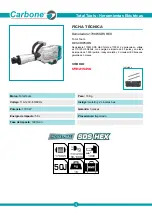
409-32048
Rev A
7
of 64
For the CAPI-6T, the PCB length & width is adjustable:
Length
60 mm to 860 mm
[2.36 to 34 in.]
Width
76 mm to 712 mm
[3 to 28 in.]
Thickness
1.5 mm to 6 mm
[0.06 to 0.31 in.]
With alternate clamps, the thickness is 4.00 mm to 10 mm [0.15 to 0.39 in.].
PCB Weight is 16 kg max [35 lbs. max].
PCB edge clearance is 3 mm [.118 in.] on the top side of the PCB.
PCB edge clearance is 4.8 mm [.187 in.] on the underside of the PCB.
Top board clearance is max: 25.4 mm [1 in.]
Bottom board clearance is max: 20 mm [.787 in.]
The minimum lower fixture height is 32 mm [1.26 in.]
The program for pressing is a simple table of connector type, position and head angle. Each pressing cycle,
called a profile, is precisely defined by the user to control force, speed, and distance as the connector is
pressed. This highly flexible technique allows a virtually unlimited variety of pressing options to satisfy the
needs of present and future connectors. Data describing the connectors, tools, PCB, and pressing profile are
programmed through Editors and stored in databases.
Pressing Methods
Pressing cycle control can be done with one of four basic techniques. The simplest is press to absolute
force. In this technique, the total pressing force for the cycle is calculated by using programmed force per
pin, multiplied by the number of pins in the connector. Thus, each connector receives the same pressing
force regardless of how much force is actually needed to seat it. This has been the technique used in the
past on simple force controlled presses.
A more sophisticated technique the CAP uses is called PARS-FPPL
, which stands for “Percent Above
Range Sample -
Force Per Pin Limited”. In this technique, the force is the average measured over a user
-
defined distance range as the connector is pressed. The pressing cycle is then terminated by continuing
to press until this average force is exceeded by a user defined percentage, to ensure complete seating.
The advantage of this method is the ability to dynamically adjust the force that is applied to match what is
actually needed, thus reducing the stress on the PCB and connector. No matter what percentage above
the average is defined, the maximum force applied is limited by the pre-defined maximum force per pin.
The “gentlest” pressing technique is press to height. This method yields the absolute minimum stress to
the bo
ard and connector because the force applied is 100% absorbed by the pin’s compliant section
interface with the board. The connector housing is pressed to a programmed height above the board
without actually touching it. It is especially useful for low force or fragile components like relays. The PCB
thickness option must be used to accommodate board and fixture thickness variations.
The final technique is called Force Gradient. This technique monitors the rate of change of force to
distance. This method is used for robust connectors that need to be seated against the board surface
firmly. Generally, the force vs. distance plot will make a steep upturn as the connector contacts the board
surface. The connector stops moving so the force rises quickly. A minimum angle is specified for the
upturn which corresponds to how solidly the connector is pressed against the board.
Board Thickness Measurement
The board thickness measurement option facilitates the press to height technique by measuring the actual
thickness of the PCB before the pressing cycle starts. If the board thickness is not measured, the program
uses the nominal thickness that is entered for the height calculations.
SPC
The SPC option provides real time data on the pressing force on each connector. Charts can be viewed
live on screen, or recalled later for review. The supporting raw data is available for local or network
access. The charts and data might be shared with the end user to increase their confidence in the quality
of the pressing process.
Bar Code Reader
Hand held bar code reader option allows PCB serial numbers to be quickly entered for tracking purposes.
Reports include the scanned serial number. Without this option, data must be typed in by the operator.








































